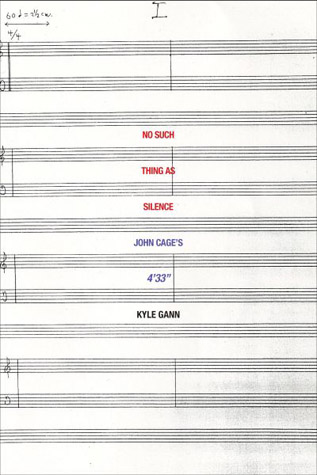
by Angela Moran

Published by Yale University Press, 2010 | 255 pages
One late evening in August of 1952, in a half-open barn cum theatre hidden somewhere in the Catskill Mountains of New York, and through the intermittent rain, a man opened and closed a piano lid three times before a silent audience. It was, as Kyle Gann tells it in No Such Thing As Silence: John Cage’s 4’33”, the premiere of a landmark musical work of the twentieth century, a work that would reach beyond that huddled crowd of avant-garde enthusiasts to influence artists as diverse as Yoko Ono, Philip Glass, and The Magnetic Fields. Gann’s book is a dissection of John Cage’s infamous “silent” piece, during which audiences are encouraged to listen—for four minutes and thirty-three seconds—not to the musician on stage but to the unplanned and inchoate sounds of their environment: the hum of the air conditioner, the staccato of raindrops, distant traffic, or even the shuffling and coughing of the impatient. All this, Cage seems to say, can be called music—if only one will listen.
4’33”—or simply “four thirty-three”—has been called many things: a philosophical statement, a piece of theatre, an experiment, a hoax. Whatever else it may be, it is also a lens through which one can read the major trends and movements of the twentieth-century art world. At a time when post-war composers like Boulez and Stockhausen were holing up in ivory towers to write maddeningly complex music with zero mass appeal, 4’33” responded instead to countercurrents directed toward upending the ways in which music had been thought of and listened to for centuries. These reversals often favored, among other things, noise and environments over absolute control, musical communities over musical individuals, and events over concrete, immortal “works.”
Cage, who liked 4’33” best of all his own creations, was nevertheless inconsistent in the way he described the piece throughout his life. Why, for instance, did it have to be exactly four minutes and thirty-three seconds, if all it was meant to do was encourage one to listen in a new way? Framed as a composition in three movements (signaled by the opening and closing of the piano lid), given a duration, and put on stage in front of a “classical music” audience, it was a jab in the ribs to starchy Western concert culture. If, on the other hand, the “silent” piece was something you could perform at any time for yourself, simply by changing your relation to the sounds around you—something Cage claimed he did often—then it is better understood as a product of the composer’s involvements with Eastern philosophy, and particularly with Zen Buddhism. A notion Cage surely took to heart was that writing and talking obscure the fundamental nature of the world; only through contemplation and meditation could it be made apparent.
Gann’s book opens up several such doorways to understanding the piece, finding traces of its thought in painters, theologians, Thoreau, and Sunday newspaper cartoons, among many more. If this review seems excessively fond of lists, it may simply be an inheritance from the book’s structure, which is full of them. Whole chapters enumerate events and figures linked to the creation of the piece, ranging from the immediate to the merely suggestive. The result is an attractive and exploratory plumb into some of the most fascinating stories of contemporary art, a mixture of history, anecdote, analysis, and primer that reveals 4’33” not as an isolated event but as a nexus for the most pressing questions of art in its time.
Gann, who has worked both as a music professor and a journalist, and also runs a classical music blog, seems to struggle with the difficulty of writing for a mass audience while delving deeply into music he is passionate about. The result is a sometimes strange contrast between, for instance, grade-school explanations of why composers write music (“quite often—they compose for the sheer love of composing, which can be an enjoyable and fulfilling activity”) and comparatively dense passages of musical analysis which might belong to a college-level textbook. The marriage of a frequently journalistic tone with the extensive employment of endnotes and bibliographic references adds to the confusion. No Such Thing As Silence may be too much for some readers and too little for others, but what is there attests admirably to the far-reaching influence of John Cage’s best-known work. 4’33” changed how music was written in the second half of the century, but—more crucially—it changed how we listen.
Dan Wang is a graduate student in musicology at the University of Chicago. He hails from Toronto.















click to see who
MAKE Magazine Publisher MAKE Literary Productions Managing Editor Chamandeep Bains Assistant Managing Editor and Web Editor Kenneth Guay Fiction Editor Kamilah Foreman Nonfiction Editor Jessica Anne Poetry Editor Joel Craig Intercambio Poetry Editor Daniel Borzutzky Intercambio Prose Editor Brenda Lozano Latin American Art Portfolio Editor Alejandro Almanza Pereda Reviews Editor Mark Molloy Portfolio Art Editor Sarah Kramer Creative Director Joshua Hauth, Hauthwares Webmaster Johnathan Crawford Proofreader/Copy Editor Sarah Kramer Associate Fiction Editors LC Fiore, Jim Kourlas, Kerstin Schaars Contributing Editors Kyle Beachy, Steffi Drewes, Katie Geha, Kathleen Rooney Social Media Coordinator Jennifer De Poorter
MAKE Literary Productions, NFP Co-directors, Sarah Dodson and Joel Craig